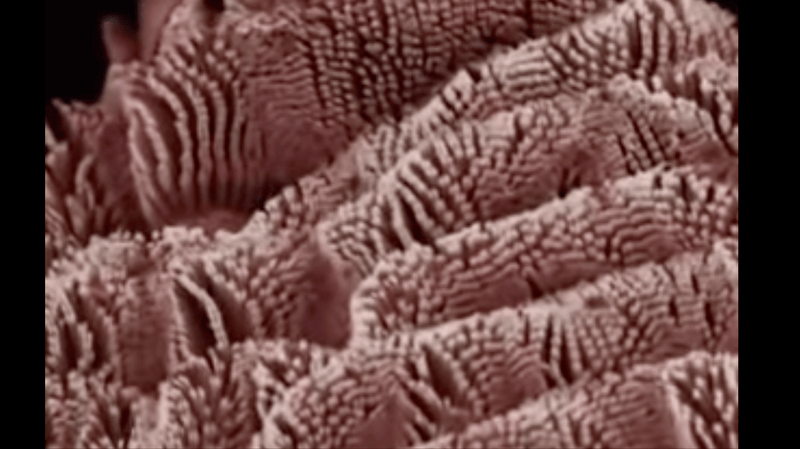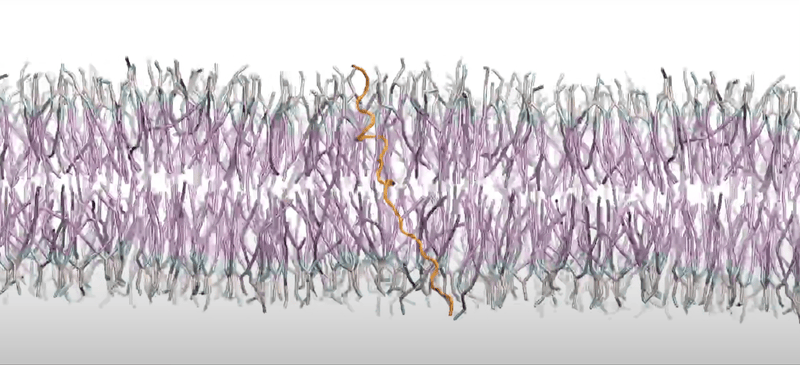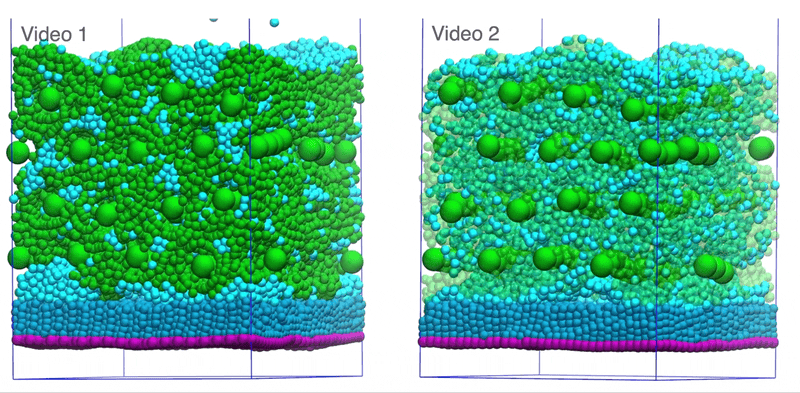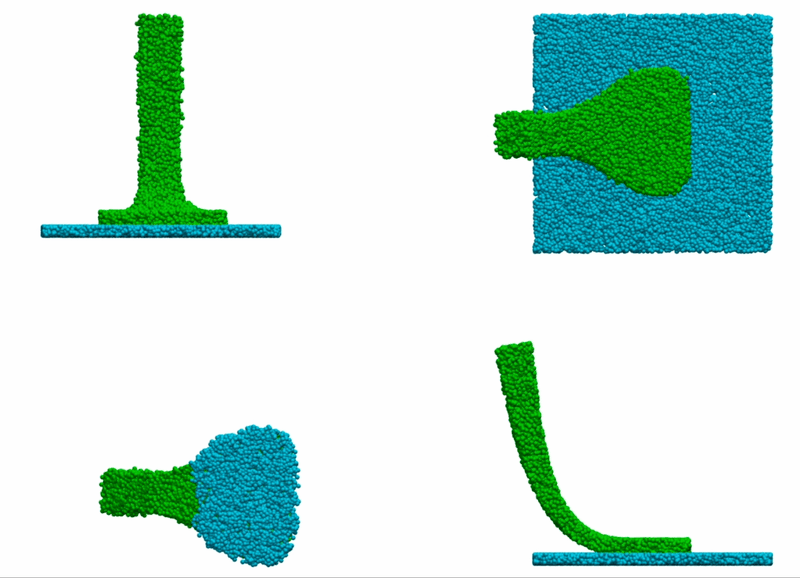I know, geckos, right? As a kid, I marveled at these nimble creatures defying gravity by a lamplight on sultry summer nights—a backdrop to family chatter. Remembering those times, I often wondered: how do geckos cling to walls so effortlessly? I was aware of studies pointing to van der Waals forces as the key to their remarkable stickiness. However, the breadth of research on gecko adhesion was something I only came to appreciate recently, thanks to an insightful reader of this blog. His curiosity was piqued by my article on Andre Geim’s random walk to the discovery of graphene, leading him to suggest I look at Müller-Plathe’s coarse-grained simulations. That’s right: coarse-grained simulations of gecko feet. Diving into these studies, I was surprised by the depth of what I found. It’s a fusion of physics, biology, and cutting-edge simulations—an effective computational microscope to examine geckos’ adhesion abilities. I’ve stumbled upon a whole world and today, dear reader, I will share it with you. Ready? Let’s go.
So, Why Gecko Feet?
Imagine robots that can climb walls and trek across any landscape; devices that can help in search and rescue missions or exploring alien frontiers. Think of cars with tire grip like nothing we’ve seen before, or gadgets assembled with flawless precision. And why not? Picture yourself scaling the façade of a skyscraper simply because the elevator’s out. All this could be within our grasp if we figure out how geckos work through their physics.
Yes, geckos, those amazing little critters.
These guys have been around since dinosaur times and boast some serious natural talents. They’re bug zappers, munching on mosquitoes and other insects. They have night vision that puts ours to shame, 350 times better, to be exact. Plus, they can pull off a neat party trick by dropping their tails and growing them back.
But the thing that really gets scientists talking is how geckos crawl up walls, hang from the ceiling without a care in the world. This marvel may not be as intriguing as the Big Bang or the origin of life, but it’s been debated over many cups of coffee through the ages.
Even Aristotle was onto geckos. Back in the 4th century B.C., he observed them “run up and down a tree in any way, even with the head downwards.”
Two millennia later, these little lizards still have us all wondering:
How the heck do gecko feet work?
The secret to gecko adhesive success lies in the sophisticated architecture of their toes. The gecko’s digits are sheathed in millions of fine hairs known as setae, which terminate in billions of even tinier structures called spatulae. I imagine them as the branching roots of a tree or the fine veins of a leaf—this is the hierarchical structure that allows a gecko to grip.
Ah, Mother Nature!
At the microscopic scale, the setae exhibit a complex design: stiff fibrils embedded within a softer matrix. This structural composition, along with the chemical makeup of β-keratin, facilitates the spatulae’s interaction with any surface through van der Waals forces. As we’ve explored in previous stories on From Atoms To Words, this type of noncovalent binding—van der Waals interactions—may seem weak when considered individually. However, when these interactions work together, they create a bond robust enough to support the gecko’s weight as it traverses various substrates.
But here’s where geckos really show off: they can unstick their feet with a mere thought, a feat dubbed smart adhesion. While their adhesive pads need to stick firmly to facilitate climbing, they must also be able to let go for the gecko to walk freely. It’s a delicate balance between friction and adhesion, all playing out in the span of a step.
Now, how have we learned all of this?
Well, since the advent of electron microscopy in the mid-20th century, researchers produced a rich body of information about the mechanism of gecko adhesion. But what’s truly exciting is that this isn’t just limited to experimental work. There’s a wealth of theoretical and computational studies too.
So, what’s actually going on at the teeny-tiny molecular level when geckos get their Spider-Man on? How do their little molecular devices work their adhesion abilities?
Stick around. It’s going to be fun.
Further reading: A review of adhesion and friction models for gecko feet | 2010

More on From Atoms To Words:
▸ Quantum Nanoreactor Simulations of The Early Universe: The Dawn of Interstellar Chemistry
▸ From Earth to the Cosmos: How Hydrogen Bonds Shape Life
▸ Curiosity, Ingenuity, Persistence – Andre Geim’s Random Walk to the Discovery of Graphene
Coarse-grained simulations of gecko adhesion
We’ve tackled the concept of coarse graining before when we discussed multiscale simulations of DNA. But a quick recap won’t hurt, right?
Coarse graining stands as a method to distill the complexity of molecular systems into something more computationally manageable. This technique clusters groups of atoms into larger pseudo-atoms or beads, each representing a more complex entity like an entire amino acid residue, for example. It’s a trade-off, essentially—we sacrifice a degree of molecular detail for the sake of broader, more extended simulation scales.
Credited to the seminal works of Levitt and Warshel in the 1970s, coarse-grained simulations have since become a cornerstone of advanced multiscale modeling. They open up the possibility of studying large biomolecular structures and molecular machines, such as the motor protein Kinesin, on a scale that would be intractable at a fully atomistic level.
Now, Müller-Plathe et al. have deployed coarse-grained simulations to unpack the effects of various conditions, like humidity and surface roughness, on the adhesion of gecko feet. This isn’t just a simulated depiction of gecko adhesion; they’re digging into the how and why.
Besides the sheer scientific coolness of their coarse-grained simulations, Müller-Plathe’s findings may turn out to be key for the design of bio-inspired synthetic adhesives. Aka, devices that would allow us to run on walls to catch a breath of fresh air.
With the scene set, we are finally ready. Let’s dive into the triad of studies by Müller-Plathe, shall we?

More on From Atoms To Words:
▸ Quantum Biology: The Fuzzy Connection Between Quantum Mechanics and Living Things
▸ The Evolution of Quantum Chemistry: From Pencil and Paper to Quantum Computing
▸ Computational Chemistry 2043: A Quantum Peep into the Future
Coarse-Grained Simulations: Three Case Studies of Gecko Adhesion
▸ Study 1: Mechanical properties of gecko-foot β-keratin
In their first set of coarse-grained simulations, Müller-Plathe et al. bring forth a computer model to simulate the behavior of β-keratin, the protein that makes up the tiny, hair-like structures on gecko toes. This model sheds light on the microscopic features that give geckos their superhero-like ability to scale walls and hang from ceilings.
The simulations depict β-keratin as a sort of biological composite material—a blend of sturdy fibers called nanofibrils set within a softer, more random, matrix-like structure that provides flexibility.
Müller-Plathe’s coarse-grained simulations revealed some striking findings, indicating that the gecko setae’s fibrillar regions boast a substantial stiffness—measured by a Young’s modulus of 13.2 gigapascals. In contrast, the surrounding softer matrix presented a lower stiffness of 2.13 gigapascals. When these two components were modeled in the ratios observed in natural gecko setae, the predicted overall stiffness was in close agreement with what’s been experimentally measured in real gecko setae (9.7 vs. 7.3 ± 1.0 gigapascals).
Not bad, considering the typical approximations of a coarse-grained simulation, right?
Now, having reproduced the experimentally known stiffness of gecko setae, Müller-Plathe et al. explored what happens when gecko setae get wet, showing that water molecules can disrupt the molecular links within the proteins, thus rendering the setae more pliable. This potentially accounts for the heightened grip in humid conditions.
But what happens when those setae touch down on a surface?
To answer this question, Müller-Plathe and team took their model a step further to simulate setae adhesion on surfaces.
Ready to climb a little higher?
Further reading: Coarse-Grained Molecular Simulation Model for Gecko Feet Keratin | 2018
More on From Atoms To Words:
▸ From Earth to the Cosmos: How Hydrogen Bonds Shape Life
▸ 60 Years in the Making: AlphaFold’s Historical Breakthrough in Protein Structure Prediction
▸ Bridging Theory and Experiment: 14 Reasons Chemical Simulations Stand as the Third Pillar of R&D
▸ Study 2: Gecko adhesion on wet surfaces
Müller-Plathe and team ventured into uncharted territory with their second investigation, employing coarse-grained simulations to capture the interplay between gecko-foot keratin and silica surfaces under varying humidity levels.
What they found was pretty unexpected: sure, a bit of moisture ramps up the stickiness of gecko feet, but it wasn’t for the reason they thought. The keratin getting softer? Nope, that’s not what’s making the grip hold.
Let’s do a bit of chemistry and discuss the crucial variable: the actual hydrophilicity of keratin, which, intriguingly, has not been determined. Not having this information, Müller-Plathe et al. simulated different keratins of varying affinities for water and showed that low hydrophilicity in keratin—less eager to bond with water—causes water molecules to act somewhat like a glue via capillary forces, boosting adhesion (see Video 1 below). On the flip side, keratin with a high affinity for water tends to absorb it, altering its adhesion dynamics (see Video 2 below).
So, what goes down at the pivotal moment of foot-surface contact?
On dry surfaces, adhesion is all about the natural chemistry between keratin and the surface. Introduce a bit of humidity, and water steps in as a nanoscale gap filler, beefing up the surface contact. This amplifies the van der Waals forces, securing that superhero grip for geckos.
So, turning the tables on the idea that the enhanced adhesion is due to a softer keratin, Müller-Plathe presents a compelling case: it’s the interaction between water and keratin the true hero in this story.
But this isn’t just a tale about water. Müller-Plathe et al. suggest that other liquids could have similar effects, casting new light on the broader principles of biological adhesion—insights that might pave the way for the creation of innovative moisture-responsive materials.
Further reading: Gecko adhesion: a molecular-simulation perspective on the effect of humidity | 2022

▸ Study 3: Gecko Adhesion on Rough Surfaces
In their latest scientific tour de force, Müller-Plathe and team have once again leveraged the power of coarse graining, this time employing it as a computational microscope to visualize the molecular mechanisms behind spatula detachment from surfaces with varied sub-micron roughness levels.
In this study, they’ve tackled a common oversimplification—previous models only looked at a snippet of the spatula, leading to an overblown estimation of the forces at play during detachment. Müller-Plathe’s approach was more holistic: it’s a mesoscale particle model that includes the full curve and contour of the gecko spatula.
Their broader computational approach, calibrated on finer-grained molecular models, reproduces adhesive forces measured in real-life experiments, with simulated pull-off forces for individual spatulae registering at 12 nN compared to the 8–20 nN measured experimentally—an excellent agreement considering the complexity of the simulated system.
Now that we’ve established that the simulations can reproduce known observables, what do we learn from them?
Well, when it comes to spatula size, think tiny for mighty strength. Smaller spatulae pull off higher forces per contact area than their larger counterparts. It’s all thanks to their stiffness, which resists peeling and keeps the pad firmly in place.
The work also gives us a view into the energetics of detachment, highlighting that a good chunk of the energy—75%, to be precise—goes into fighting off the spatula’s own adhesive nature, while the rest is dedicated to bending the spatula until it snaps back, free at last, with a tiny fraction dissipated as heat (about 5%).
But wait, there’s more. The angle of attack, or the spatula’s inclination, also plays a vital role. Like a climber finding the best handhold, the spatula’s adhesion varies with its angle; too steep (> 60°), and the forces become erratic, potentially leading to unreliable adhesion—bad news for synthetic adhesives aiming to replicate geckos’ biological wonder.
Müller-Plathe et al.’s big takeaway?
Besides the spatula size and inclination, the adhesive force significantly depends on the characteristic surface roughness. Gecko spatulas stick most effectively not just to any old rough surface, but to one where the peaks and troughs are optimally spaced—specifically, where the contact area covers roughly 60% of the spatula pad’s area.
Further reading: Gecko adhesion on flat and rough surfaces: Simulations with a multiscale molecular model | 2022

More on From Atoms To Words:
▸ Large Language Models for Chemistry: Is the Beginning of a New Era?
▸ Serendipity in Science: What’s its Fate in the Age of AI?
▸ ReaxFF Molecular Dynamics: Simulating Complexity Beyond Quantum Chemistry
A final personal touch
Whew, that was quite the informational journey. Let’s hit the pause button and distill the essentials from this info-rich brew, shall we?
First off: studying geckos’ feet isn’t just a cool exercise. It’s fertile ground for pioneering devices we’ve only seen in comics, like those Spider-Man boots you’d need when the elevator’s out of service.
Now, let’s talk simulations—specifically, coarse-grained simulations. Studies like those of Müller-Plathe and team showcase how these models are really like computational microscopes that shed light on complex phenomena all around us. It’s not just about our sticky-toed friends; as we’ve already seen on From Atoms To Words with our story on DNA, coarse-grained simulations can help make sense of complex biological processes too.
Pretty neat, huh?
On gecko adhesion, we’ve learned that water molecules act as a sort of mediator. On a slightly moist surface, the water fills in all the small gaps and imperfections, ensuring that the gecko’s foot has more area to stick to. And indeed, size does matter—smaller spatulae paired with just the right amount of surface roughness equals gecko super-hero stickiness.
My personal takeaway?
The world of simulations is vast and mighty, with each new study reaffirming and expanding the role of simulations as the third pillar of scientific discovery, alongside theoretical and experimental approaches.
And finally, a last word on scientific research: It never ceases to amaze me. When critics claim scientists lack creativity, they fail to see that in scientific research, from the study of gecko toes to the exploration of the universe’s beginnings and the origin of life, there’s no limit to human ingenuity.
Wouldn’t you agree?
If you enjoyed this dive into the world of geckos’ adhesion abilities and coarse-grained simulations, I’d love to hear your thoughts. Agree, disagree, or have a totally wild theory of your own? Let’s connect! Subscribe to my LinkedIn newsletter and let’s keep the conversation rolling.
READ | THINK | SHARE
From Atoms To Words
Today’s Story Filed Under:
